-
![LANG-CODE-KEY]() LANG_NAME_KEY
LANG_NAME_KEY
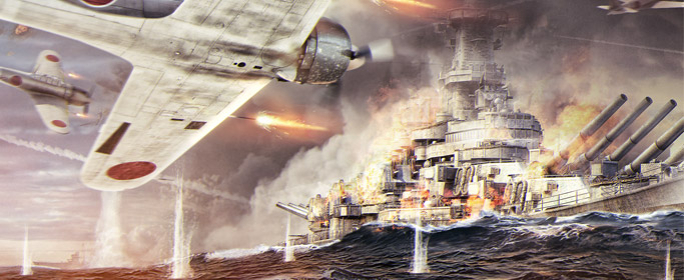
These words rang through the halls of the United States Congress on December 8, following Japan's massive attack on Pearl Harbor, and brought the U.S. into World War II.
Pearl Harbor remains a stinging memory in U.S. history: the embodiment of a surprise attack, but also a haunting instance of a magnificent military force -- the Pacific Fleet -- devastated because of lack of preparedness, and perhaps excessive pride. The attack itself was meticulously planned and executed, and left the United States Navy reeling.
The details of Pearl Harbor -- the developments leading to it, the attack, and the aftermath -- are among the most widely discussed events of the 20th century. The Japanese began their planning long before December 7, in response to trade embargoes imposed by the United States. The leaders of the Japanese Empire felt war was inevitable, and Japan had to strike first against U.S. forces.
Their goal was simple, if incredibly audacious: cripple the United States so that it couldn't retaliate. The fulcrum of their strategy was to attack Pearl Harbor, the mighty Pacific fortress of the U.S. Navy. In order to attack on the base's relatively shallow waters, Japan developed special training and weaponry. The country's carrier-based aircraft, used in an unprecedented manner and scale, were able to deliver a resounding blow through history. Though the United States were the ultimate victors, the nature of naval warfare was forever changed.
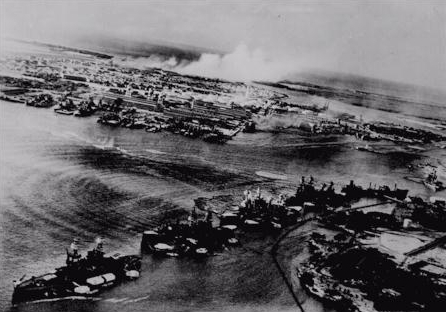
Captured Japanese photo showing the rows of ships
The attack on Pearl Harbor reads like a screenplay. One can almost hear the popular music of the time as the base operated on stand-down. Many Army and Naval personnel were on leave for the upcoming holiday, and the ships were in tidy rows. All that was expected was a group of B-17 flying fortresses arriving later in the day. In stark contrast, the Japanese were fully set for war: their strike force of 20 ships, five mini-subs, and 350 planes were making their final maneuvers to reach optimal range for the assault.
The first indication of enemy action to the U.S. was a submarine periscope spotted by the U.S. minesweeper Condor. It called for aid, and the destroyer U.S.S. Ward responded aggressively, firing at the unidentified submarine and dropping a full spread of depth charges. Ward sent a detailed message saying they engaged, but Pearl Harbor commander Admiral Husband E. Kimmel took no further action. A second indicator came when a radar station reported one of the largest aircraft formations they'd ever seen. This, however, was also ignored, on the presumption that the aircraft were the inbound B-17 bombers from San Francisco.
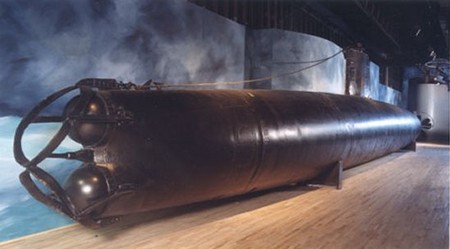
Japanese mini-sub Ha-19, captured when she grounded during the attack
Therefore, the base was completely unaware until, at roughly five minutes before 8:00 AM, the first of the Japanese planes began their attacks. Initially they targeted the airfields and the ships at harbor, where vessels and aircraft laid in neat rows. The torpedo and dive bombers began their runs on targets anchored in the shallow waters of the harbor, while fighters strafed the airfields.
It was during this first wave that an armor-piercing bomb fatally struck the U.S.S. Arizona. The battleship exploded, killing 1,177 men. The next hour was a sea of chaos. Many ships were on fire or sinking, while others frantically raced to escape the harbor while trying to engage anything in sight. General quarters sounded across all decks and men sprinted to their positions.
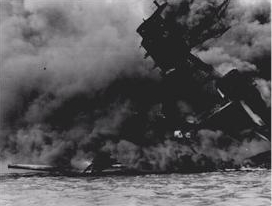
The U.S.S. Arizona after being struck
By the time the second wave of Japanese bombers and fighters arrived, U.S. personnel had barely begun to man their positions to fight back. Despite increasing volumes of AA fire, the Japanese successfully hit the battleship Pennsylvania, damaged the destroyers Cassin and Downes, and struck the light cruiser Raleigh. One bomb blew off the bow of the destroyer Shaw.
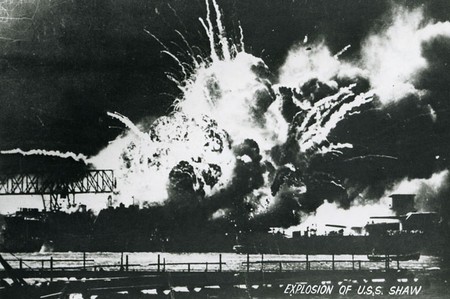
Explosion of U.S.S. Shaw
After two hours of strikes, the Japanese fighters returned home to their carriers after a successful mission. The United States' losses were heavy: all eight battleships of the Pacific Fleet were heavily damaged. Five, including the Arizona, were marked as sunk; three cruisers damaged; three destroyers heavily damaged; and a total of 188 planes destroyed. In contrast, the Japanese lost only their six specialized mini-subs and 29 planes. In a stroke of luck, the U.S. carriers -- Lexington, Enterprise, and Saratoga -- were not in port, which dismayed Japanese forces, as they were primary targets.
The following day, Roosevelt gave his famous speech to Congress and the American people. The United States entered the war as an Allied power, projecting its force into Europe while at the same time beginning the retaking of the Pacific. The remembrance of the attack on Pearl Harbor is an event recognized around the world, but taken most seriously in Japan and the United States. Each year, on the anniversary of the fateful day, people gather to remember the attack and honor those who fell.

The plaque given to Wargaming as Keepers of the Wall. The names include: G.R. Young S1c, J.W. Young S1c, V.L. Young WT1c, and J.V. Zeiler S1c
We honor those at Pearl Harbor. In 2014, Wargaming was one of the largest contributors, in conjunction with AMVETS, to replace the marble wall at the U.S.S. Arizona Memorial. In recognition, a piece of the weathered wall was presented to the company, where it is displayed at the Austin studio as a solemn reminder of those who perished. As ships sail and guns blaze throughout our games, never forget those who laid down their lives on December 7, 1941.
Kansas native Tim St. Arnold attended the University of Nebraska--Lincoln, studying History with minors in Anthropology and Political Science. At Wargaming, he's able to put his passions for military history and gaming to work as a researcher.
http://www.nationalgeographic.com/pearlharbor/history/pearlharbor_timeline.html
http://www.popsci.com/technology/article/2012-12/vintage-popsci-pearl-harbor
http://www.pacificaviationmuseum.org/pearl-harbor-blog/pearl-harbor-the-bombs-of-the-second-wave
http://www.timeanddate.com/holidays/us/pearl-harbor-remembrance-day
http://www.hawaiialive.org/viewer.php?resource=573&hostType=res&hostID=556